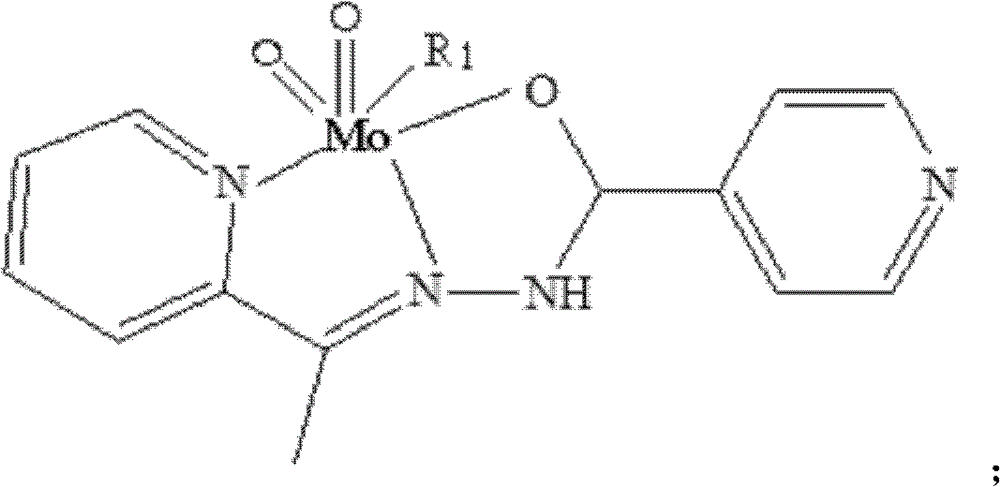Method for producing propylene epoxide through propylene epoxidation reaction
An epoxidation reaction, propylene oxide technology, applied in the production of bulk chemicals, chemical instruments and methods, organic chemistry, etc., can solve the problems of undisclosed use of propylene epoxidation, etc., and achieve excellent catalytic performance, low cost, Simple to use effects
- Summary
- Abstract
- Description
- Claims
- Application Information
AI Technical Summary
Problems solved by technology
Method used
Image
Examples
Embodiment 1
[0020] Weigh 10 mmol of isoniazid, put it into a round-bottomed flask (50 ml) containing 20 ml of absolute ethanol, heat and stir at 50° C., add 10 mmol of 2-acetylpyridine after the isoniazid is completely dissolved, After stirring for 1 hour, let it stand still. After 7 days, the white needle-like crystals were separated by suction filtration, and washed with a small amount of ethanol to obtain 2-acetylpyridine isonicotinoid hydrazide Schiff base complex.
[0021] Weigh 5mmol of 2-acetylpyridine isonicotinoyl hydrazide Schiff base complex, put it into a round bottom flask (50ml) containing 15ml of absolute ethanol, heat and stir at 75°C, and wait until 2-acetylpyridine isonicotinoyl After the hydrazine is completely dissolved, add 5 millimoles of molybdenum acetylacetonate, stir to form a black powder, continue to heat and stir for 2 hours, filter with suction, wash with ethanol, and dry in vacuum at 40°C to obtain a black powder product. Its structural formula is as follows,...
Embodiment 2
[0024] Weigh 10 mmol of isoniazid, put it into a round-bottomed flask (50 ml) containing 20 ml of pyridine, heat and stir at 50°C, add 10 mmol of 2-acetylpyridine after the isoniazid is completely dissolved, and stir for 1 After 7 days, the white needle-like crystals were separated by suction filtration and washed with a small amount of ethanol to obtain 2-acetylpyridine isonicotinoid hydrazide Schiff base complex.
[0025] Weigh 5mmol of 2-acetylpyridine isoniazid Schiff base complex, put it into a round bottom flask (50ml) containing 15ml of pyridine, heat and stir at 75°C until 2-acetylpyridine isoniazid is completely After dissolving, add 5 millimoles of molybdenum acetylacetonate, stir to have black powder to separate out, continue to heat and stir for 2 hours, suction filtration, vacuum 40 ℃ after washing with pyridine to obtain the product, its structural formula is as follows, its infrared analysis spectrum and figure 1 resemblance.
[0026]
Embodiment 3
[0028] Take tert-butyl hydroperoxide, n-propanol and 2-acetylpyridine isonicotinoid hydrazide molybdenum complex synthesized in [Example 1] and put them into a high-pressure reactor, seal the reactor and start heating and stirring. When the preset 100°C is reached, the high-pressure pump pumps in propylene, and the amount of propylene is determined by the pumped volume. Reaction timing, after reaching 2 hours, take off the reactor, cool to 10-15°C with ice water, and take the liquid phase into a frozen sampler. Continue to freeze the sampler at minus 20°C for 30 minutes, then unscrew the air valve, slowly release the propylene in the sampler, open the sampler, quickly transfer the remaining liquid to the chromatographic sampling bottle, seal it, and perform chromatographic analysis.
[0029] Reaction conditions: reaction temperature 100°C, reaction time 2 hours, rotating speed 540rpm, tert-butyl hydroperoxide (TBHP) addition 70 millimoles, n-propanol addition 50 millimoles, ca...
PUM
 Login to View More
Login to View More Abstract
Description
Claims
Application Information
 Login to View More
Login to View More - R&D
- Intellectual Property
- Life Sciences
- Materials
- Tech Scout
- Unparalleled Data Quality
- Higher Quality Content
- 60% Fewer Hallucinations
Browse by: Latest US Patents, China's latest patents, Technical Efficacy Thesaurus, Application Domain, Technology Topic, Popular Technical Reports.
© 2025 PatSnap. All rights reserved.Legal|Privacy policy|Modern Slavery Act Transparency Statement|Sitemap|About US| Contact US: help@patsnap.com



